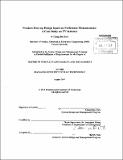Product line-up design based on preference measurement : a case study on TV industry
Author(s)
Park, Chang Bae, S.M. Massachusetts Institute of Technology
DownloadFull printable version (5.859Mb)
Other Contributors
System Design and Management Program.
Advisor
Juanjuan Zhang.
Terms of use
Metadata
Show full item recordAbstract
Sony, in 2010, introduced innovative product line-up setting process for its TV, using the technique of market segmentation and conjoint analysis. This practice was expected to increase its sales compared to traditional vertical line-up, as academia has for long asserted that meeting specific needs of consumer groups in customized way with the most preferred combination of features identified through conjoint analysis is a way to bring the most willingness to pay from consumers. However, contrary to its estimate, Sony lost its market share significantly in 2010. In this thesis, I analyze how Sony actually came up with needs-based product line-up and check on whether there has been any problem in its process reflecting on the framework proposed by academia. Consequently, three possible reasons to explain its failure were identified: -- The result of conjoint analysis should have been used in market segmentation; -- Purchasing decision of TV is not made at the individual level; -- Use of Meta attributes in conjoint analysis can be beneficial. In order to address the first issue, I recommend Sony to adopt a componential segmentation to execute both consumer segmentation and conjoint analysis, while for the second to consider the effect of group decision mechanism onto its conjoint analysis and to introduce consumer segmentation concept into the model of calculating group utility. Finally, in order to reflect Meta attributes in its conjoint analysis more properly, I propose that Sony should adopt prototype in preference measurement process, take business-oriented perspective in product planning process, and prepare to reshuffle its product line-up from scratch. Those recommendations will ensure increase of the efficiency of preference-based product line-up setting in estimating market reaction.
Description
Thesis (S.M. in Engineering and Management)--Massachusetts Institute of Technology, Engineering Systems Division, System Design and Management Program, 2011. Cataloged from PDF version of thesis. Includes bibliographical references.
Date issued
2011Department
System Design and Management Program.; Massachusetts Institute of Technology. Engineering Systems DivisionPublisher
Massachusetts Institute of Technology
Keywords
Engineering Systems Division., System Design and Management Program.